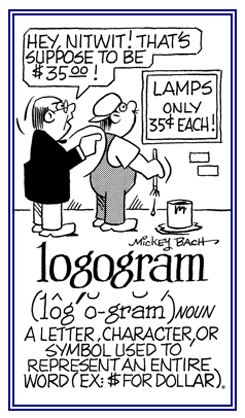grapho-, graph-, -graph, -graphy, -grapher, -graphia
(Greek: to scratch; to write, to record, to draw, to describe; that which is written or described)
As indicated at the bottom of this page, there is a significantly large number of graphic word-entry groups in this unit. Such an extensive listing is provided to show how important the grapho- element is to the English language.
lithography
1. A description of stones or rocks.
2. The art of engraving on precious stones.
3. The art or process of making a drawing, design, or writing on a special kind of stone (called lithographic stone), so that impressions in ink can be taken from it.
2. The art of engraving on precious stones.
3. The art or process of making a drawing, design, or writing on a special kind of stone (called lithographic stone), so that impressions in ink can be taken from it.
Also, a planographic printing process using metal or plastic plates with a sensitized coating on which the matter to be printed is fixed chemically, before the non-printing areas of the plates are dampenedd and the remainder printed with greasy inks on flat-bed or cylinder presses.
lithostratigraphic
1. A reference to stratigraphy which is based on the physical and petrographic properties of rocks.
2. Relating to a written interpretation of the physical characteristics of sedimentary rocks.
2. Relating to a written interpretation of the physical characteristics of sedimentary rocks.
lithostratigraphy
1. Stratigraphy based on the physical and petrographic properties or categorization of rock strata based on their lithology (color, texture, and composition).
2. A written interpretation of the physical characteristics of sedimentary rocks.
3. The study and correlation of strata to elucidate earth history on the basis of their lithology, or mineral content, grain size, texture, and color of rocks.
2. A written interpretation of the physical characteristics of sedimentary rocks.
3. The study and correlation of strata to elucidate earth history on the basis of their lithology, or mineral content, grain size, texture, and color of rocks.
logagraphia
1. The inability to express ideas in writing.
2. The loss of power to express thoughts by means of spoken words as a result of a disease or injury of certain brain centers.
2. The loss of power to express thoughts by means of spoken words as a result of a disease or injury of certain brain centers.
A sign, symbol, or character representing a word: A logogram can be used, alone or in combination with other symbols; such as, the graphic representation of a whole word as a single letter (¢, $, £, ¥, ™®, #, &, %, ¶, ©).

© ALL rights are reserved.
Go to this Word A Day Revisited Index
Some logograms are found on road signs, in advertising, etc., and all are designed to represent in simple graphic form an object, a concept, or an attitude.

Go to this Word A Day Revisited Index
so you can see more Mickey Bach illustrations.
logographer
1. A story writer: short-story, novelist, etc.
2. A writer of spoken language in longhand as opposed to shorthand.
3. A prose writer in ancient Greece.
3. A prose writer in ancient Greece.
logography
1. The art of arranging letters for printing.
2. A method of printing in which whole words, or syllables, are cast as single types.
3. A mode of reporting speeches without using shorthand; for example, a number of reporters, each in succession, take down three or four words.
2. A method of printing in which whole words, or syllables, are cast as single types.
3. A mode of reporting speeches without using shorthand; for example, a number of reporters, each in succession, take down three or four words.
loxodograph
A device for recording ship's oblique course or to record a ship's travels.
lunarography
1. The description and delineation of the moon’s surface.
2. The descriptive science relating to the moon; also, selenography.
2. The descriptive science relating to the moon; also, selenography.
Large-scale, usually highly theoretical, geographical study: In the beginning, Mr. Rock explained the concepts of macrogeography in order to give the students general and wide-ranging geographical concepts of the planet Earth.
macrograph
1. A drawing, photograph, or other representation in which something appears at its actual size or larger.
2. A representation of an object that is at least as large as the object.
2. A representation of an object that is at least as large as the object.
macrography
1. Abnormally large handwriting, often the result of a nervous disorder in the writer.
2. Examination of objects with unaided eyes.
3. Abnormally large handwriting.
2. Examination of objects with unaided eyes.
3. Abnormally large handwriting.
macrophotography
Photography in which objects are reproduced larger than or at their actual size but without the degree of magnification that use of a microscope would give.
magnetogram
A graphic representation of magnetic field strengths and polarity.
magnetograph
Related "writing" word units:
glypto-;
gram-;
scrib-, script-.


